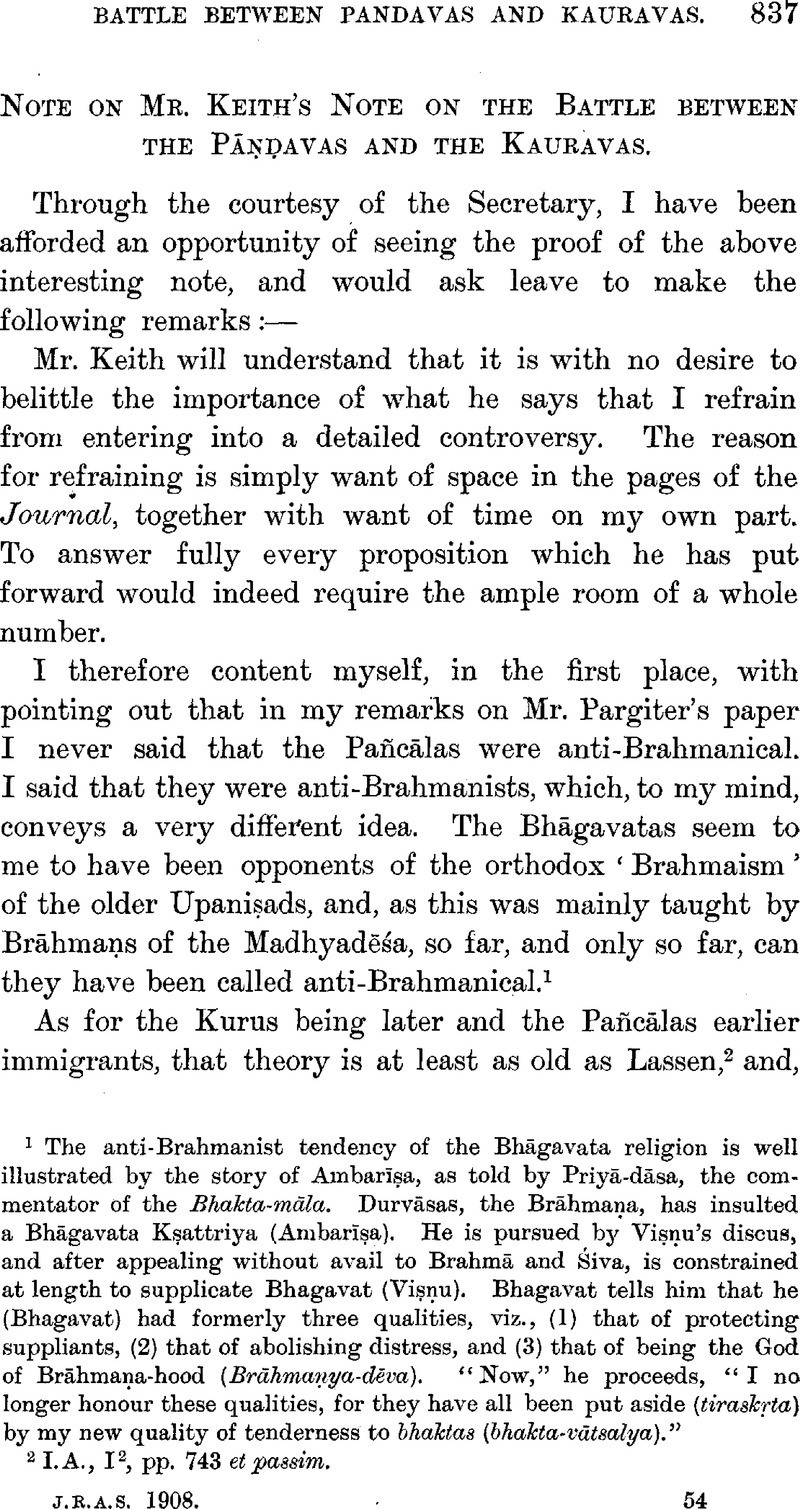No CrossRef data available.
Article contents
Note on Mr. Keith's Note on the Battle between the Pāṇḍavas and the Kauravas
Published online by Cambridge University Press: 15 March 2011
Abstract

- Type
- Miscellaneous Communications
- Information
- Copyright
- Copyright © The Royal Asiatic Society 1908
References
page 837 note 1 The anti-Brahmanist tendency of the Bhāgavata religion is well illustrated by the story of Ambarīṣa, as told by Priyā-dā;sa, the commentator of the Bhakta-māla. Durvāsas, the Brāhmaṇa, has insulted a Bhāgavata Kṣattriya (Ambarūṣa). He is pursued by Viṣṇu's discus, and after appealing without avail to Brahmā and Śiva, is constrained at length to supplicate Bhagavat (Viṣṇu). Bhagavat tells him that he (Bhagavat) had formerly three qualities, viz., (1) that of protecting suppliants, (2) that of abolishing distress, and (3) that of being the God of Brāhmaṇa-hood (Brāhmaṇya-dēva). “Now,” he proceeds, “I no longer honour these qualities, for they have all been put aside (tiraskṛta) by my new quality of tenderness to bhaktas (bhakta-vātsalya).”
page 837 note 2 I. A., I2, pp. 743 et passim.
page 838 note 1 See, for instance, Mr. Risley's Chapter on Caste in the last Indian Census Report.
page 839 note 1 See, for instance, ProfessorMacdonell, , in the Indian Empire, vol. ii, p. 235.Google Scholar
page 839 note 2 I.A., I2, pp. 703, 713. I merely quote Lassen as the oldest authority I know of, and not because he has not had many followers.
page 840 note 1 Even so late as the eleventh century A. D. the country inhabited by the Kurus (not Kurus and Pañcālas) was looked upon as the true home of Brahmanical orthodoxy. In the second Act of the Prabōdha-candrōdaya we have the unorthodox Cārvāka congratulating King Mahāmōha that all the world has abandoned the Vēdas. “Even in the Kuru-kṣētra, not to speak of other countries, nothing is to be feared from learning or know ledge.” Kuru-kṣētrā-”diṣu tāvad dēvēna svapnē'pi na vidyā=prabōdhō-'dayaḥ śaṅkanīyaḥ.
page 840 note 2 It might even be argued that the compound ‘Kuru-Pañcāla’ referred not to two related tribes but to the country inhabited by two sets of opposing tribes, of whom the Kurus and the Pañcālas were respectively the leaders. It is in this sense that we talk of the ‘Kuru-Pañcāla war.’ See also the passage already referred to by Professor Macdonell in the Indian Empire.
page 841 note 1 Chh. Up., I, viii, 1, and V, iii ff.Google Scholar Cf. Brh. Ar., VI, 2,Google Scholar and Sab. Br., XIV, viii, 16.Google Scholar
page 842 note 1 As illustrating the frequent touches showing the connexion, pace Mr. Keith, between the Bhāgavata bhakti religion and Sāṁkhya-Yōga, we may note that the word ‘Śāṇḥilya’ is a patronymic from ‘Śaṇḥilya.’ The latter (see Colebrooke, , Misc. Essays, ii, 167Google Scholar) was a son of Kaśyapa, who married thirteen daughters of Dakṣa. Dakṣa's thousand sons were taught Sāṁkhya by Nãrada himself (MBh., I, lxxv). This is all that we know about them.Google Scholar
page 842 note 2 He was a father-in-law of Daśaratha (Rām. II, i, 2), a fact which brings him into close connexion both with the Eastern Aryans and with the Bhāgavata religion.Google Scholar
page 842 note 3 The question as to how the Kurus got to the Madhyadēśa has been frequently discussed elsewhere. See, for instance, my Languages of India, pp. 52 and 65.Google Scholar
page 843 note 1 Bhāg. Pu., III, xxi, 26.Google Scholar
page 843 note 2 MBh. XII, 12,986. We may perhaps note this in connexion with what I said about the Lunar and Solar races in my former remarks.Google Scholar
page 843 note 3 See MrPargiter, , p. 333.Google Scholar


